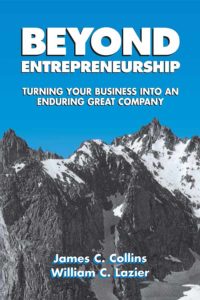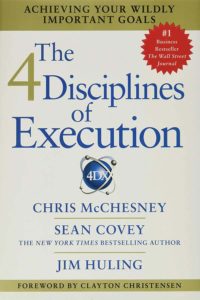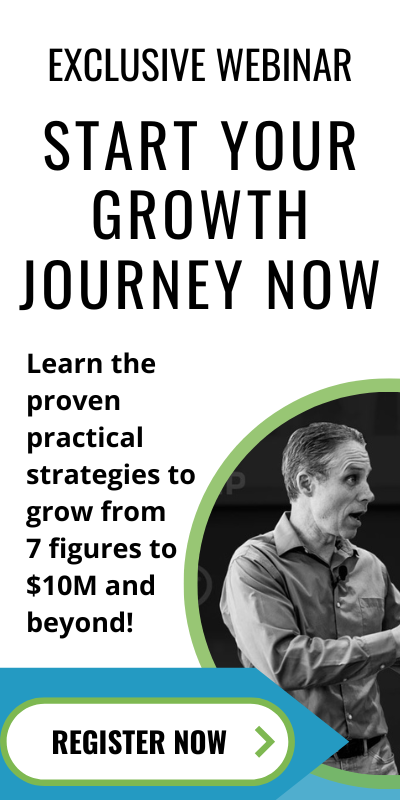Episode 4: Developing Intentionality And Discipline, With Brett Gilliland
Brett Gilliland is Founder and CEO of Elite Entrepreneurs, a company that specializes in giving $1M+ business owners the knowledge, processes, and tools to grow to $10M and beyond. Brett is an expert in organization development, leadership, and strategy and spent 10 years helping Infusionsoft grow from $7M in revenue to over $100M. Brett was involved in the foundational work of Purpose, Values, and Mission at Infusionsoft and facilitated the strategic planning process for many years.
One of Brett’s favorite professional accomplishments is co-creating Infusionsoft’s Elite Forum along with Clate Mask and building the Elite business inside of Infusionsoft. As the leader of the Elite business, Brett has helped hundreds of struggling seven-figure business owners overcome their biggest challenges and achieve new levels of success. He also played a central role in the development of Infusionsoft’s Leadership Model and was serving as the VP of Leadership Development when the decision was made to spin the Elite business out of Infusionsoft. As the new owner of Elite Entrepreneurs, Brett can’t think of anything else he’d rather be doing professionally. When Brett isn’t busy helping $1M+ businesses succeed, he is a family man who enjoys spending time with his beautiful wife, Sharon, and their 8 children.
What the podcast will teach you:
- Why six-figure strategies won’t work for seven-figure companies
- The need for a Vision for your business, especially once you make your first million
- Delegating tasks so you aren’t wearing a hundred hats as you try to grow your business
- What other business owners and thought leaders have done to grow their companies from $1 million to $10 million or more
- The path to navigate the challenges that come with expanding your business beyond the seven-figure mark
Resources:
- Jim Collins author page on Amazon – https://amzn.to/2ne0DeX
- Start With Why by Simon Sinek on Amazon – https://amzn.to/2njn0Qk
- Email: info@GrowWithElite.com
- Website: https://growwithelite.com/
—
Welcome to this episode. I’m excited about this particular episode because I’m venturing out. This is my first attempt at a solocast. I hope I’m not putting you to sleep, but I promise that if you will hang in there with me, you will find some great value in what I’m going to share with you. The first thing I want to do might be a little unconventional. I’m going to ask you a question that I genuinely want you to reflect on.
I’m going to pretend like we’re having a two-way conversation even though I can’t see or talk to you directly. Here’s the question. I want you to think for a moment about people you admire who have accomplished great things or who are successful. For clarification, I’m not talking about people who necessarily drive fancy cars or have a lot of money.
They may have those things as a result or as a byproduct of their success or their accomplishments. I’m talking about people who have made significant contributions or who have achieved something great, whether it be in a business, a nonprofit, a community, a school, a church, or even in the home with their family. Think about somebody who has done great things in whatever sphere of work or influence they have been in. Here’s the question.
How did they do it? How did they achieve greatness? How did they accomplish significant results? How are they so successful in what they did? Why are they somebody that you would admire? While you think of some of the reasons that they may be able to do what they have done, I’m going to oversimplify this a little bit. I believe that if we boiled down all the reasons that you could come up with for why they were so successful or why they were able to achieve significant results, you would find two essential ingredients. That’s what I want to talk to you about.
The first ingredient is what I call intentionality. I didn’t make that word up. I’m sure you’ve heard that before. That first ingredient is somebody has an intention and the desired outcome that they’re going for. The second ingredient that anyone with significant achievements would have if we boiled it all down is discipline. In other words, they are clear about the desired outcome that they wanted, they went to work and made it happen.
This may sound super oversimplified. You might argue, “There was some luck involved. They had unique access to people and resources. They had some gift or talent that was born with them.” All of those may be true to some extent. In my experience, the right people with the right resources or even somebody with a talent or gift might have that unlocked if they know what they want.

Intentionality And Discipline: People will be attracted to you when you put your words to a powerful purpose they can get behind.
The right people and resources will be attracted to them. The right things will come into play if they know what they want. They can see that clearly. They have clearly articulated goals or objectives, and they have the discipline to go to work. They have the tenacity and the grit to go to work to make that happen. That’s what I want to talk about, intentionality and discipline. I want to move our conversation because this show is all about organizations and businesses that want to do great things.
Personal Vs. Organizational
I want to draw out for you the parallel between personal effectiveness and organizational effectiveness. Let’s get personal with this. I believe strongly that an organization or your company is effective when it is intentional and has the discipline to go make that intentionality a reality. It’s how to translate an idea, a goal or an objective into real results. It’s intentionality and discipline.
I’m arguing that an organization is a living thing. It’s an organism. It has life. You give it life because you breathe purpose into this business. When you started it, it had a purpose. Whether or not you clearly articulated it, it had objectives. Customers who pay you are interested in what you provide to them. There’s life in this organization. Without that meaning or without people to make it go, it would be lifeless. While there’s still a business, there’s life there.
I believe that just like an individual who achieves greatness, who does significant things in the world, and who contributes in a way that is extraordinary or admirable, a company can learn to do those same types of things. There are just more complications because it’s more than one person. There’s more complexity. How do we help your company become very intentional and disciplined to achieve extraordinary levels of results? That’s what I would like to talk to you about.
There are good companies everywhere but the ones that stand out have mastered these two things, intentionality and discipline. Any of you who will tune in to my show over the next weeks, months and years will find that I’m a huge Jim Collins fan. I love Jim Collins and everything that he talks about because to me, his research and the way that he writes about the great companies that he has studied bear out or point out this very thing that we’re talking about.
The greatest organizations and the best entrepreneurs out there figure out exactly what they want and how to go get it. They have this intentionality and this discipline to make it happen. What you will find is that Jim Collins says, “The number one responsibility of every great leader is to set the vision.” What do I mean by setting the vision? We’re speaking to that intentionality part.
Become a great leader by helping your organization. Be clear on your purpose and align your resources, time, and energy towards that. Share on XSetting the vision in Jim Collins’ framework and the one that I’ve adopted that we teach and have taught hundreds of elite entrepreneurs like you is made up of three distinct components. Setting the vision means getting clear on your purpose, values and mission. Those are the three things. Your number one responsibility as a leader if you want to be a great leader is to help your organization or people get clear on the purpose, the values and the mission, and then align all of the resources, effort, time and energy towards that. That’s getting intentional.
Purpose
Let me say something about each of those briefly here. The first element to setting a good vision is to get clear on your purpose. I’ve already mentioned Jim Collins. I’ll go ahead and mention Simon Sinek, another thought leader here that I certainly appreciate if not extremely valued. Many of you will be familiar with his work. One of his early writings or content pieces was around Start with Why. That goes well with this concept in Jim Collins’ framework of setting vision or purpose.
What is the purpose? What is the meaning? What is the impact of your business on the world? What is the thing it was meant to do? What is the cause behind your business? It’s how you like to describe it. Sometimes I use the phrase, “Why does your business deserve to have a life?” That is the purpose of your business. I promise you that it’s not to make money. We want to make money in our businesses but there’s a greater purpose.
When you figure out how to put words to the greater purpose in your business, you will unlock a lot of potential energy that’s bottled up there. People will be attracted to it. I’m not talking about employees who are going to come work for you. I’m talking about customers, partners, and even investors. Anybody who needs to be involved in moving that purpose forward will be attracted to you and your company when you put words to a powerful purpose that people can get behind.
Values
That’s the very first element of a powerful vision. Your number one responsibility is to set the vision. The purpose is the first element of a good vision. The second element of a good vision if we’re using the Jim Collins framework is value. That’s the second element. If the purpose is the why, values are the how. It’s a way of being. It reflects the core beliefs of this company. The living organism that is your company has core beliefs, whether you’ve put words to them or not. It’s the collective or shared sets of beliefs and the resulting behaviors that you value in your company.
If you’ve done any work with values, you may have one or two-word values like honesty or customer service. There are some things that you value in your company that become non-negotiables in the way that you operate with one another, your customers and your partners. There’s no audience-specific set of values. It’s the way that we are with everyone who we operate with.
That makes it simple because you just have to get clear on those values once, and then you can live them with everyone. You can hire them, lead them or fire them. Unfortunately, you have to fire them occasionally. You hire, lead and fire to these. You partner with people based on these. You will likely attract customers who value the fact that those values are the way that you behave in your company. That’s the second element of setting the vision.
Mission
To be repetitive as you will find that I am when I’m trying to help people learn something, vision is made up of three elements. It’s the purpose, values and mission. I’m going to talk about the mission now. The purpose is the why. Values are the how or the way of being. Mission, in the way that I view it, is the what. It’s a very specific thing that we’re up to. I like a three-year timeframe.
If you’re trying to set the vision for your company, you get clear on the destination of where we’re going over the next three years. You set it and then align everyone to it. The mission should be measurable. For example, our mission at Elite Entrepreneurs is to help elite entrepreneurs grow meaningful businesses. If you haven’t got a sense of that yet, you can tell I’m a little passionate about purpose-driven and values-based companies.
That’s a meaningful business by our definition. It’s also meaningful when people do this right and when you, as an elite entrepreneur, build a company the way that I’m describing. It will become meaningful in size, scale, and scope of impact on the world and how you serve your customers. It’s meaningful in two ways. One is that it’s purpose-driven and values-based. It’s a benefit to everyone connected to it. Two, it’s meaningful in terms of its size and scope. You will grow a meaningful business.
That’s our mission. Our mission is to help 1,000 elite entrepreneurs grow meaningful businesses by 2021. That’s more definition on it. I told you it needed to be destination-oriented. I started with a generic, “We’re in business to help you lead entrepreneurs grow meaningful businesses.” That’s a generic statement. Many businesses make that mistake leaving it at that, whereas a good destination-oriented mission will have a specific what by when.
I put the added clarity on that for you with, “Our mission at Elite Entrepreneurs is to help 1,000 elite entrepreneurs grow meaningful businesses by the end of 2021.” Does that mean their business will be meaningful by the end of 2021? It will in terms of purpose-driven and values-based. It may take longer for those businesses to get where I would like to see them get, but you can see that there’s additional clarity when I put the quantitative measurement of 1,000 elite entrepreneurs by a specific point in time or by the end of 2021. That gives the clarity that my organization needs to go and do what we’re meant to do on the planet.
Businesses are established to make money, but there must be a greater purpose. Figure that out and unlock a lot of potential energy that attracts people. Share on XI hope that I’ve illustrated sufficiently for you the very specific components of a good vision by using the Jim Collins framework. It’s the purpose, values and mission. If you’re looking for a reference on that, there’s a little-known book written by Bill Lazier with James C. Collins. It’s the first book that Jim ever got involved with. It’s called Beyond Entrepreneurship.
Before all of his famous books that we all love, there was one out there that you can still find and buy called Beyond Entrepreneurship. In that book is where you will see this framework. He teaches to start with values, purpose and mission, but I like the nuance or the twist. We will use Simon Sinek that way. We will start with why or purpose and then go to values and mission. To me, that’s a great framework for vision.
The reason we talked about any of this is that effective people and effective companies are intentional. They get clarity on these key components. Your number one responsibility as a great leader is to set the vision. I’ve taught you the three key elements of setting a good vision. What you didn’t hear me say is there’s a vision statement. In my way of viewing the world, there is not a vision statement.
You’re not saying, “Our vision is to do this big thing in the world.” Setting a vision properly in my way of doing it is to start with why, set purpose, go to the values, and then create a very specific destination-oriented mission so that you can hang strategies off that, annual priorities and quarterly priorities. We can talk about that later. Purpose, values and mission are how you set a great vision for your company.
That’s the intentionality piece. Once you get super intentional, it helps to enroll your team in the process of getting intentional so you don’t just ascend to the top of the mountain and come down with the answers. You tell them, “I’m starting to see something more meaningful and bigger for our company. I want to enroll you in the process of bringing a ton of clarity to that vision. Once we get clear on the purpose, values and mission, then you all are going to help make that real.”
You’re going to go from entrepreneur to CEO. Part of that journey for you is to become a leader that can enroll others in not only seeing a bigger picture but taking coordinated action together to achieve greater results. There’s a journey that each of you is on as an elite entrepreneur. It’s the journey from entrepreneur to CEO. In that process, you’ve got to become the leader your company needs you to become to grow beyond where you are.

Intentionality And Discipline: If you’re setting the vision for your company, get clear on your destination for the next three years.
Discipline
To make that transition in leadership capability for yourself, you’re going to have to learn, “How do I enroll my team in the process of articulating a powerful vision that we can then get excited about together to take coordinated action to achieve those bigger things?” That’s enough on intentionality. I’m going to shift to the other key component of successful people and successful companies. I’m going to summarize that component as the discipline.
The way that I want to talk about that shows up as a very rhythmic meeting cadence in your business. That’s what it looks like. Behind that is a process for turning your vision into reality. It’s the way that we have to work. In a company, there’s the added complexity of multiple people, not just one person making me get up every day, exercise for 30 minutes, read a couple of chapters of a book, or pull the weeds out of my garden. It’s whatever discipline you need to apply personally to achieve personal goals.
There’s added complexity in a business where you have to coordinate action. You have to pull people together to see a common thing, and then work together to make it happen. You do that through a meeting rhythm. That’s where the discipline comes in. Most of us know what it looks like day in and day out in your business. It has very aptly been described by the people at Franklin Covey who wrote a book called The 4 Disciplines of Execution or 4 DX for short.
They call it the whirlwind. It’s your day-to-day chaos and everything is coming at you like responding to customers, employee matters, and maybe complaints from neighbors or landlords. There’s stuff that happens in your business every single day. Key machinery or equipment breaks down, somebody no-shows, the customer is not happy with how something went, or you’re having trouble making payroll and having to do some creative financing maneuvers to get money in the right place at the right time.
All of these things are constantly coming at you. It’s chaotic. I’m going to call that the whirlwind. I like that term. You have to break away from the whirlwind on a specified cadence to coordinate, communicate, and make sure we’re reorienting everyone to the thing that we’re all up to together. If you do not break out of the daily chaos, it will consume you, pull you, and run your business and your life.
Annual Planning
Anybody who wants to do great things in business must get clear on where we’re going and how we’re going to achieve that together, and then be disciplined in the execution of that clarity. I’m going to propose, strongly suggest or prescribe that you set up the following meeting cadence in your business if you want to do extraordinary things. First of all, you must have annual planning offsite. Once a year, you’ve got to get in ideally before the year begins towards the end of the current year.
To become a capable leader, you need to learn how to enroll your team in the process of articulating a powerful vision. Take coordinated action and achieve bigger things. Share on XYou get together with your leadership team or whatever that may look like. If that’s a leadership team of 1 or 2, that’s fine. I will encourage you over time to build a leadership team that can grow your company where it needs to grow. I don’t mean to outpace what you can afford. I’m not talking about that. There’s a prudent and responsible way to grow yourself as a leader and then eventually your leadership team so that together, you can lead this company forward to new levels of success.
Once a year, you’ve got to pull out of the business for a couple of days, get away from the office, and go somewhere you can see clearly and have creativity where you cannot be distracted by the day-to-day demands of your business. Get offsite. At that annual planning, you would reorient to the purpose, values and mission. Make sure that everybody is clear on those things, that we’re aligned to that, and that the strategy is clear about how we’re going to achieve that mission.
If it’s a destination-oriented mission, you’re going to be able to choose between all the different paths. You could take tools or help with you on that journey. You’re going to select a few key levers to pull again and again. That’s your strategy. In this annual planning, you’re going to get clear on the annual priorities for the year. You’re going to be a clear owner. There is going to be clear evidence of success for that priority.
At the end of the year, we’re going to be able to look back and say, “Did we accomplish what we set out to accomplish?” Clear annual priorities, clear owners, and clear evidence of success must happen in each annual planning session. There’s going to be a set of quarterly priorities that come off of those Specific, Measurable, Achievable, Relevant, and Time-bound tasks. If you heard me go through the SMART acronym, we call them SMARTs.
That results in you achieving your quarterly priorities. They’re annual priorities in support of a strategy to achieve the mission, quarterly priorities in support of annual priorities, and then SMART objectives or tasks that are going to happen this quarter to achieve quarterly priorities and annual priorities, which ladders up to the mission. You can see a cascading of intentionality and more detailed plans that we can execute that are all aligned to us achieving our intentional mission.
Annual planning is the first meeting. The annual offsite has two purposes. It’s the annual plan and the first quarter’s plan. In the other three quarters of the year, you will have a quarterly planning offsite, which will be 1 to 2 days as well. It’s the same rules. Get out of the office and shut off the phones and the laptops. Get everything that’s distracting from the day-to-day out of the way and plan the next quarter.

Intentionality And Discipline: If you don’t break out of the daily chaos, it will consume you and run your life. Somebody who wants to do great things in business must know where they are going.
There are annual meetings, quarterly meetings, and monthly meetings to make sure that you’re on track with your quarterly plans and to talk about anything that bubbles up from the weekly operational meeting, which is the next meeting. Quarterly meetings are more strategic progress in nature. Monthly bridges those two. Some check in on progress towards the quarterly. Some take the necessary time as a leadership team to talk about what’s going on from an operation standpoint.
Daily Huddle
Anything that bubbles up in a weekly dashboard meeting that you can’t handle, you might talk about as a leadership team in a monthly meeting. I hope I’m painting a picture for you of the continuum of meetings more operational, which are the weekly meetings, and more strategic, all the way up to the annual meeting. I’m going to introduce one more tactical meeting called the daily huddle. This isn’t one that I’ve made up.
There’s some great stuff out there including Verne Harnish. He has a book called Scaling Up. His previous book was called Mastering the Rockefeller Habits. In there, he talks about daily huddles and the importance of gathering the team briefly each morning to start the day and make sure we’re all aligned to the daily objectives and seeing clearly any potential obstacles that might be in the way. We’re clearing a path for team members to get the stuff done that must be done to move the work forward.
Daily huddles are quick 5 to 10-minute stand-ups or quick meetings, “Here’s what I’m up to today. Here’s what I perceive as any obstacles. Here’s what I could use help from the team on to make sure I have a successful day.” We’re going around the huddle quick person by person, checking in on what needs to happen that day, and making sure people are focused. Weekly meetings are more of a leadership meeting but they might be a full team meeting depending on the size of your company. What are the key metrics in the business? How are we tracking those every week? Are there any adjustments we need to make?
It’s still operational but it’s not the daily huddle. It’s company-wide KPIs, “How are we tracking those?” It’s the dashboard. It’s making necessary adjustments on a weekly basis. If things bubble up in that weekly meeting that needs more attention and time than we can afford in that weekly meeting, then we can put those two to a monthly meeting, which might be a four-hour or half-day meeting where we’re doing some operational big rocks and things that bubble up that we should discuss further in more depth at greater length. That bubbles up to more like a monthly meeting.
In that same monthly meeting, we can bridge to how we are tracking towards our quarterly priorities. There’s the operational execution machine of running your business every single day. That’s got to happen, then there’s the more strategic progress part of your business to build the capabilities and move your strategies forward that will enable you to achieve your mission at the end of that three-year period, we talked about earlier.
I know it’s hard without any visual aids to get through some of this, but I hope that what you’re hearing is there must be sufficient intentionality in your business. It has to be clear enough for everybody involved to know exactly why we’re doing what we’re doing, what is the purpose, and how we’re going about our work day in and day out with the values, and the very specific destination-oriented mission that we’re up to now.
When we achieve that mission, we will plant that flag on the ground and say, “We’re done with that,” and we will go on to the next mission. That’s the intentionality piece. You’ve got to marry that with the discipline and the meeting rhythm or a good cadence. It’s the heartbeat of your company. It’s how we know we’re on track and we’re taking coordinated action to achieve that mission that we talked about in setting the vision.
Going Full Circle
To bring this full circle, if you think about people you admire, they can be at school, in the community, at church, in business, or wherever you see people who have demonstrated excellence. Whether or not you see the day-to-day detail, you’ve found someone who has gotten clear about what they want to accomplish and then put the discipline in place to manage their own calendar, time and desires even to focus on the things that will achieve the results thereafter.
You have to do that for your business, not alone. You’ve got to help the team come together in a way to take coordinated action and achieve something intentional. Those are the two components. I hope that you see the parallels between personal effectiveness and organizational effectiveness. Your journey from entrepreneur to CEO must include leadership development on your part to become good at setting the vision and then be excellent at executing against that vision.
That excellence comes in the form of discipline. I recommend highly a meeting rhythm to keep that on track. All you’re doing is carving out time and space in a calendar for people to come together. Remind one another to get clear again on what we’re up to, how we’re choosing to go about our work and the strategy, and then the very specific priorities that we’re up to for this quarter to move the needle forward on that plan. You’re taking coordinated action together through a discipline of a meeting rhythm.
I hope that was helpful for you. We have helped hundreds of businesses and business owners like you get clear in the vision-setting process. If you want help with that, we can certainly do that. That’s not my aim for this. I want you to get clear. You’ve got to be intentional and have discipline in your business. If you let the whirlwind of the day-to-day pull you in every direction, you’re not going to make intentional progress toward the things that you want to do, and you’re going to be stuck.
If you find yourself stuck at a certain revenue point year after year, or you feel like you’re just spinning wheels, or you might be having some organic growth but you’re not having the breakthrough results that you want, I suspect there’s a problem either with the clarity of your intentionality or the discipline of your meeting rhythm.
Pretty much those two areas are the areas where I see problems with most business owners. Hopefully, you found that helpful. I look forward to sharing additional insights with you on future solocast. You will enjoy it more and I certainly will when you get to hear from the great guests that I’ll be bringing in our next episode. Until next time, thank you and much success to you.
Important Links
- Jim Collins
- Start with Why
- Elite Entrepreneurs
- Beyond Entrepreneurship
- The 4 Disciplines of Execution
- Scaling Up
- Mastering the Rockefeller Habits
- Info@GrowWithElite.com
Want to listen to more? View all episodes here >





